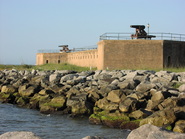 Click image to enlarge.
Click image to enlarge.
 Click image to enlarge. Click image to enlarge. Fort Gaines, along with Fort Morgan, was one of the key sites in the Battle of Mobile Bay. Significant for its masonry architecture, Fort Gaines is today among the best-preserved nineteenth-century brick coastal fortifications in the country. However, its location along the Gulf Coast shoreline has always made it a prime target for erosion, and deterioration of this landmark continues to worsen over the years. The Town of Dauphin Island and many others are now seeking funding to preserve this landmark. Inside the massive brick walls of Fort Gaines are five pre–Civil War brick buildings, blacksmith quarters used for living history demonstrations, a museum, a gift shop, and tunnels leading to the corner bastions. A portion of the site also includes the Endicott batteries of the Spanish-American War period.
0 Comments
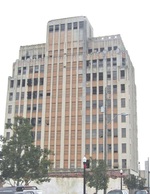 Click image to enlarge. Click image to enlarge. Constructed in 1929, the Ramsay-McCormack building is an impressive ten-story structure that once overlooked the Ensley steel mills. It is one of the early steel frame “skyscrapers” in the Birmingham area and features Art Deco-style elements such as “step-backs” and fine interior details, including terrazzo-style floors, Carrara glass, and marble. Four years after the mill’s closure in 1979, the city of Birmingham acquired the building, but plans for it never materialized. Though empty since 1986, it has been deemed structurally sound. The fate of the Ramsay-McCormack building remains uncertain at this point, as the city considers either demolition or renovation. 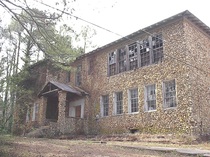 Click image to enlarge. Click image to enlarge. Now empty, the Old Rock School is a local landmark in Springville, once providing classroom space for high school students. The school may be the largest surviving chert-rock structure in St. Clair County, representing a type of folk construction—the application of indigenous chert rock to a building’s façade, which appears to be unique to certain north and north-central Alabama counties. Constructed primarily during the 1920s, ’30s, and ’40s, many of these structures have today disappeared from the Alabama landscape. Discussion about tearing down the old school concerns many in Springville, who want their landmark to be saved and put to a new use. One promising option may be for the building to become a much-needed new location for the public library. Lowndesboro Colored School , Lowndesboro, Lowndes County, c.late 19th Century (Places in Peril 2008)10/20/2008 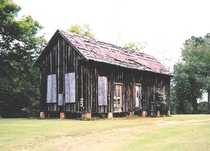 Click image to enlarge. Click image to enlarge. Dating from the late nineteenth century, the old Lowndesboro Colored School is one of Alabama’s oldest surviving African American schoolhouses. The board-and-batten structure is now deteriorated and used only for storage, but much of the exterior remains intact. Local residents also recall seeing the old blackboards when the structure was used in recent years as a laundromat. Local preservationists hope that the rare and significant Lowndesboro Colored School, now in private ownership, can be restored and eventually included on the annual community pilgrimage tour. 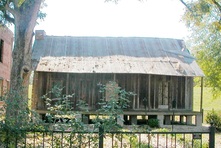 Click image to enlarge. Click image to enlarge. After vandals broke out windows and set fire to the old Folsom house in rural Coffee County, preservationists and local officials were determined not to lose one of their most treasured landmarks. This building was not only an exceptionally intact example of a late-nineteenth-century farmhouse, it was also the birthplace of James Folsom, forty-fifth and forty-seventh governor of Alabama—and the only resident of Coffee County ever to be elected to the post. In 2003 the Coffee County Commissioners obtained the house from the Folsom family and set out to preserve it. Several options were considered, but the community decided to move the house next to the old jail in downtown Elba. Today the house needs repairs. The City of Elba is still recovering from two major floods in the 1990s, so additional funding is unavailable right now to restore the house. |
Alabama's Endangered Historic LandmarksEach year since 1994, Alabama Heritage has highlighted threatened historic sites throughout Alabama. The “Places in Peril” list has identified more than 215 imperiled historic resources throughout the state, and is compiled by the Alabama Historical Commission and the Alabama Trust for Historic Preservation. The locations highlight the results of deferred maintenance, perceived obsolescence, development pressures, and lack of funding—forces that now more than ever threaten our cultural legacy. But awareness is a powerful force, too, and can cultivate a renewed determination to be responsible stewards of our heritage. For more information, visit the AHC or the ATHP websites. Alabama Heritage is proud to bring to you a selection of the places designated as perilous. Please keep your comments to information relevant to the featured place in peril. Alabama Heritage reserves the right to delete any comment that we deem inappropriate. Archives
May 2024
|

 RSS Feed
RSS Feed